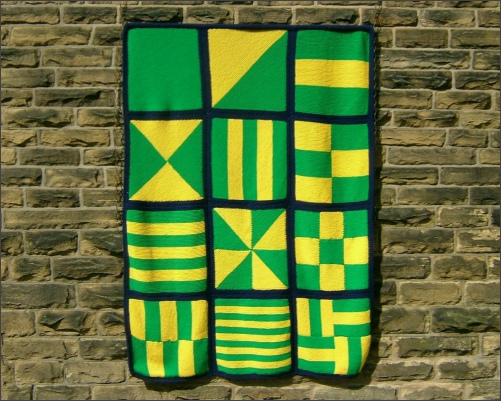




We had the idea of representing fractions on an afghan. The first square is one piece, the second is two identical pieces, the third is three pieces, and so on. We first thought of using different colours for each piece but decided that would be messy and difficult to understand. Two colours would be more dramatic but it would have to be possible to easily identify individual pieces.
We could have opted for stripes -
Equal Parts was not the original title of this afghan but it has had this name for so long that we can’t remember what the original name was. The new name came about by a strange twist of fate.
We wanted to send some pictures to an acquaintance who happens to be the author of some books published by Tarquin Publications. I knew I could reach him through his publisher so wrote a letter, enclosed some photographs, sealed the envelope and sent it to the publisher with a covering letter asking that it should be forwarded. A few days later, between Christmas and New Year, the phone rang late one night. On the other end was a rather embarrassed man who didn’t know quite where to begin. It transpired that he was Gerald Jenkins, the owner of Tarquin, and, for some reason that he didn’t understand himself, he had opened the envelope with the photographs. He was so impressed with Equal Parts that he wanted to use it as a poster for schools. We had no time to think about it as his catalogue was going to press immediately after the Christmas break and he needed to know whether it would be in there or not. Naturally, we agreed. He asked if we could redraw it in a format that the printers’ computer system could use. Again we agreed. He phoned back a couple of hours later to say that he no longer needed us to redraw it as he had done it himself and it was ready to go. All he had changed was the name. That poster is still being sold to primary schools and we often walk into schools and see it hanging there. Few teachers make the link between that and us, even though our names are printed on the bottom.
There are many ways to split a square into equal areas if the resulting pieces don’t have to be alike. If, for example, the square is to be split into five, calculate the number of stitches needed to make the whole square, divide that number by five and make that number of stitches in each of the five colours. The stitches could be completely at random but almost impossible to count and show to be of equal numbers.
